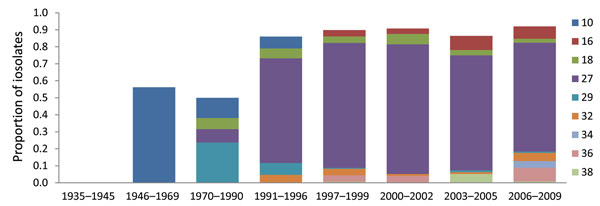Volume 18, Number 8—August 2012
Research
Population Diversity among Bordetella pertussis Isolates, United States, 1935–2009
Figure 4

Figure 4. . . Frequency (by proportion of all isolates tested) of predominant multilocus variable number tandem repeat analysis (MLVA) types within the Bordetella pertussis population, United States, 1935–2009. MLVA 10 was dominant in period 2 (1946–1969) but decreased through periods 3 (1970–1990) and 4 (1991–1996) while MLVA 18, 27, and 29 emerged. MLVA 27 increased in proportion during period 4 and dominated the population for the rest of the study period; however, the proportion of MLVA 27 has been decreasing since period 6 (2000–2002), allowing for the emergence of other types.
Page created: July 19, 2012
Page updated: July 19, 2012
Page reviewed: July 19, 2012
The conclusions, findings, and opinions expressed by authors contributing to this journal do not necessarily reflect the official position of the U.S. Department of Health and Human Services, the Public Health Service, the Centers for Disease Control and Prevention, or the authors' affiliated institutions. Use of trade names is for identification only and does not imply endorsement by any of the groups named above.